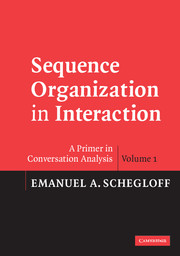Book contents
- Frontmatter
- Contents
- Preface
- Acknowledgments
- 1 Introduction to sequence organization
- 2 The adjacency pair as the unit for sequence construction
- 3 Minimal, two-turn adjacency pair sequences
- 4 Pre-expansion
- 5 The organization of preference/dispreference
- 6 Insert expansion
- 7 Post-expansion
- 8 Topic-proffering sequences: a distinctive adjacency pair sequence structure
- 9 Sequence-closing sequences
- 10 Sequences of sequences
- 11 Retro-sequences
- 12 Some variations in sequence organization
- 13 Sequence as practice
- 14 Summary and Applications
- Appendix 1 Conversation-analytic transcript symbols
- Appendix 2 Transcript of a telephone call
- References
- Index
7 - Post-expansion
Published online by Cambridge University Press: 05 September 2012
- Frontmatter
- Contents
- Preface
- Acknowledgments
- 1 Introduction to sequence organization
- 2 The adjacency pair as the unit for sequence construction
- 3 Minimal, two-turn adjacency pair sequences
- 4 Pre-expansion
- 5 The organization of preference/dispreference
- 6 Insert expansion
- 7 Post-expansion
- 8 Topic-proffering sequences: a distinctive adjacency pair sequence structure
- 9 Sequence-closing sequences
- 10 Sequences of sequences
- 11 Retro-sequences
- 12 Some variations in sequence organization
- 13 Sequence as practice
- 14 Summary and Applications
- Appendix 1 Conversation-analytic transcript symbols
- Appendix 2 Transcript of a telephone call
- References
- Index
Summary
It is the import of the conditional relevance of a second pair part given the recognizable occurrence of a first that a sequence cannot be possibly complete after a first pair part but before its second pair part. A sequence can end there – as, for example, when someone storms out of a room abruptly – but one major component of “abruptness” can be just this: ending the sequence before its recognizable closure. In this respect, a sequence is like a turn, a conversation, or any other recognizably structured unit which does not just end, but has a recognizable form of closure (Schegloff and Sacks, 1973).
With the production of a second pair part this constraint on sequence completion is met, and some sequences are recognizably complete (to their participants and to other observers) at the end of the second pair part turn. This is commonly the case with sequences which have no preference structure, such as greetings and leave-takings or “bye-byes.” Although on occasion a third or fourth offering may be made to such sequences (especially if the first round was done in overlap), commonly enough a first and second greeting (or “bye bye”) complete the exchange.
Beyond that, under a range of circumstances – for some sequence types, in some contexts, for some types of response – the parties may treat the occurrence of a second pair part as the end of the sequence, and embody this by going on to a new sequence or allowing the talk to lapse.
- Type
- Chapter
- Information
- Sequence Organization in InteractionA Primer in Conversation Analysis, pp. 115 - 168Publisher: Cambridge University PressPrint publication year: 2007
- 2
- Cited by



